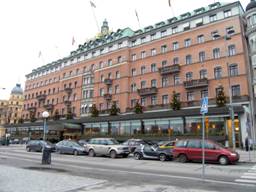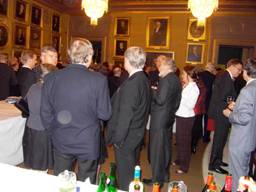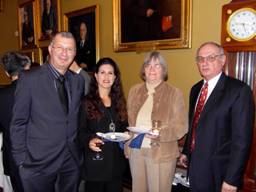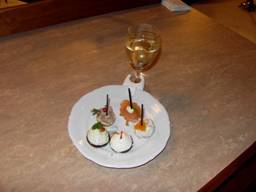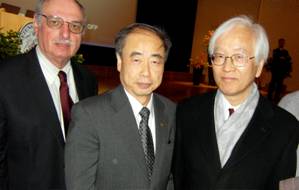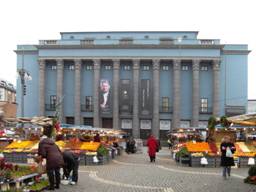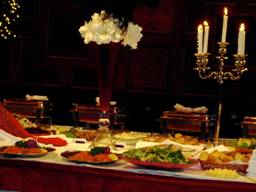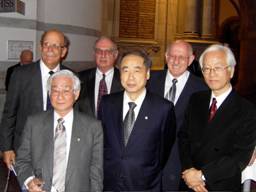This guest essay comes from David Hitlin, Caltech physics professor, and founding spokesperson for the BaBar collaboration at SLAC National Accelerator Laboratory.
I'm in Stockholm at the activities associated with the Nobel Prize awarded to Makoto Kobayashi and Toshihide Maskawa (one half), and to Yoichiro Nambu (one half). Previous SLAC Director Jonathan Dorfan and I were invited by Kobayashi to attend, along with our KEK colleagues, in recognition (cited in the Nobel press release) of the contributions of BaBar and Belle in proving the relevance of the CKM phase as the source of CP violation in the Standard Model. I arrived in Stockholm on Sunday evening; Jonathan will arrive on Tuesday. There are a variety of activities throughout the week, some of them for Laureates only, of course, and others involving their guests. I'll briefly here try to give you some description of the activities of the week.
Saturday, December 6
Arrive via London. There is an excellent direct express from Arlanda airport to the central train station, which is about a kilometer from the Grand Hotel, the center of activities for the week. All guests are advised to stay here; buses to all activities leave from here.
Sunday, December 7
8:15 bus to the Royal Swedish Academy of Science (complete, of course, with busts of Linneaus), the scene of the press conference for the Physics, Chemistry, and Economics prize. The Economics prize is not strictly a Nobel Prize; that is, it is not funded by the Nobel Foundation, but rather by the Bank of Sweden. All mentions of it here use the careful phraseology "the Economics Prize in honor of Alfred Nobel". Professor Nambu, who is 87, was unable to come to Stockholm; his prize will be given to him in Chicago on December 10 (the anniversary of Nobel's death), the same day the other prizes are awarded in Stockholm.
The press conference was organized as a few questions from the moderator, with most questions from the assembled journalists. As all three of the physics laureates and one of the chemistry laureates are of Japanese origin, the press contingent, particularly those wielding cameras, were dominated by Japanese journalists. Maskawa-san delivered his remarks in Japanese, with excellent simultaneous translation. The substantial majority of questions were directed to Paul Krugman, Economic Sciences Laureate and New York Times op-ed columnist. Most of these were of the "is the work you did relevant to saving the world in the current economic crisis" variety. Krugman's answer was basically no, but he said some reasonably complimentary things about Obama's economic team, and did point out that the Japanese crisis of the '90s were important in preventing things from going as far as a real depression, in that they showed us what techniques work and which didn't. The questioning became so skewed in Krugman's direction that the moderator pointedly asked at some point for questions specifically directed to the physics and chemistry laureates. In response to a question about lessons learned from their accumulated experience, there was, perhaps not surprisingly, a clear theme, particularly from the Americans, decrying the post 9/11 restrictions on access of foreign scholars to the United States, as well as a nostalgic call for an unfettered, curiosity-driven research environment, as opposed to the current trend towards directed, short-term research goals.
Reception at the Academy
Back to the Academy for a reception at 5, with wine and classic Swedish finger food. Fairly close quarters in two rooms, with the groups associated with each discipline tending to remain quite separate.
Monday, December 8
Nobel Lecture
The Nobel Lectures are held at the Aula Magna of the university, a very attractive large auditorium with a dramatic wooden ceiling in classic Swedish modern style. The physics lectures were at 9 a.m. Nambu's lecture was delivered by Giovanni Jona-Lasinio, Nambu's collaborator on the famous paper on interacting fermions with broken chiral symmetry leading to a Nambu-Goldstone boson. The lecture, written by Jona-Lasinio from notes provided by Nambu was personal, gave a clear historical perspective and was quite fascinating.
Kobayashi emphasized the Japanese contribution to the development of the Standard Model, beginning with the Sakata Model of hadronic consituents (an influential forerunner of the quark model), through Gell-Mann, Levy, and Cabibbo and the KM paper and culminating with neutrino mixing. He treated in some detail the experimental contributions of BaBar, Belle, SuperKamiokande, etc. to the development of our current understanding of the Standard Model. Maskawa's talk, delivered in Japanese with simultaneous translation on Powerpoint slides, was a more personal look at the KM paper, again starting with the milieu of the Sakata group and tracing his detailed path to the connection between three quark generations and a CP-violating phase. At the end of the lectures, it was Maskawa-san who was preferentially mobbed by the photo-journalists, perhaps because his lecture in Japanese communicated more directly with the bulk of the press corps.
Concert
The Nobel concert, held at the Stockholm Concert Hall, was conducted by Sir John Eliot Gardiner. The Nobel guests were seated in the first balcony, flanking the central royal box, holding King Carl XVI Gustaf and his retinue. There was serious security attending the king, but it was quite unobtrusive. The first half of the program consisted of Dvorak's Symphony No. 7, which was beautifully played, with crisp, alive rhythm and fabulous woodwind playing.
There was unfortunate scattered applause between movements, much to the annoyance of the conductor. The second half work was Mozart's unfinished Mass in C, K. 427, with the Montiverdi Choir, the Eric Ericson Chamber Choir, and four soloists. The performance emphasized the operatic, rather than the sacred aspect of the work. There were a number of extraneous touches, such as having the choruses twice execute a finite rotation to bring the sopranos and altos together, and then to separate them, and having the trombones sit among the chorus members, standing up to play. This performance was also disfigured by inappropriate applause between sections.
Japanese Embassy reception
Each of the relevant embassies hosted a noon reception. The Japanese reception was in the Winter Garden of the Grand Hotel, complete with a receiving line including the ritual exchange of business cards. There was a small ceremony, with the three Japanese national laureates who were present (Kobayashi, Maskawa, and Chemistry Laureate Osamu Shimomura, from Woods Hole and the BU Medical School, but a Japanese citizen) each making charming, self-effacing remarks about their experience of receiving the prize. A traditional Swedish smörgåsbord followed.
Nordisk Museet reception
The imposing main hall of the Nordic Museum was the site of a late afternoon reception. Music was provided by a flute, harp, and ‘cello trio. Jonathan arrived from South Africa in time for the reception, having just received a degree honoris causa from the University of Capetown the previous day.
Wednesday, December 10
Nobel Award Ceremony
We are bussed to the Concert Hall for the award ceremony. Dress is white tie and tails. ID is required at the door and is carefully checked, as is the validity of the ticket itself; tickets to the award ceremony and banquet are reputed to have substantial black market value. The guests of the Laureates are seated in the front second balcony. The stage is arranged for the King and his retinue, the Laureates, members of the Swedish Academy, the Nobel Foundation, and the committees. The Royal Stockholm Philharmonic Orchestra is squeezed into a space above the rear of the stage. They play a series of short selections interspersed with the speeches and award presentations. The recitation of the details of each of the Laureates work is presented in Swedish by the chair of the respective committees; there is an English translation in the program. The King seems to carefully read the English version of the Physics citation as the recitation proceeds. The other awards presented tonight are Chemistry, Medicine or Physiology, Literature, and Economic Science; the Peace prize is awarded on the same day in Oslo. The ambience is impressive, solemn, and dignified, following a rather detailed protocol. The proceedings take something over one hour.
Nobel Dinner
We then proceed by bus in the rain to the Stockholm City Hall, the scene of the quite spectacular banquet. Once again, tickets and IDs are carefully scrutinized. The very large and imposing central court of the building is the banquet venue. There is a very long central Table A for the Laureates, royalty, and other dignitaries, and about thirty other long tables, with a carefully constructed seating plan detailed in a printed booklet. The King and Laureates enter to a fanfare down a formal staircase. There are quite a number of students, easily distinguished by their fresh faces and student yachting caps, white for the university and black for the technical university (or vice versa, as at least one of them changes colors with the season). The students come in several varieties: guests, waiters, and ushers. The menu consists of a cold shellfish entrée (champagne), beef tenderloin (a 2000 Pomerol), and a pear dessert (a beerenauslese), with coffee and brandy at the end. The food is excellent, as is the service. Between courses there is a performance (lip-synched from the great René Jacob recording) of four extracts from Cosi Fan Tutte, by a local avant garde troupe and students from the mime and "neo-circus" programs of local schools. They appear dressed as the wait staff and pantomime a slapstick story involving lots of sliding down the big staircase and some juggling. This had nothing to do with the opera per se, but was amusing. After dinner, we proceeded to the first floor where a forties-fifties style dance band launched into (polka-like) Swedish favorites and then lots of Come Fly With Me-type standards.
Jonathan's comment was "It was an extraordinary experience in every way--storied, thrilling, hallowed, and spectacular."
Nobel Night Cap
The formal activities are followed by a student-organized, industry-supported Nobel Nightcap party at the university, from midnight to 5 AM. As I had a very early plane, I skipped this one.
n.b. Sorry for the quality of some of the photos. Lighting conditions were often marginal, and on Wednesday the SD card in my camera failed, so I had to resort to my iPhone camera.
By David Hitlin, Caltech



